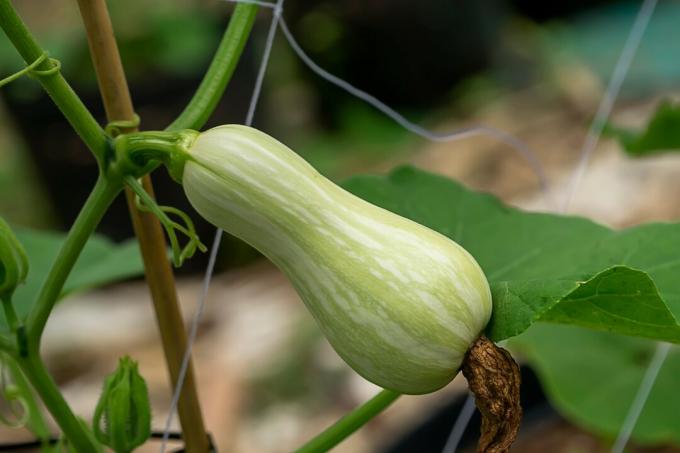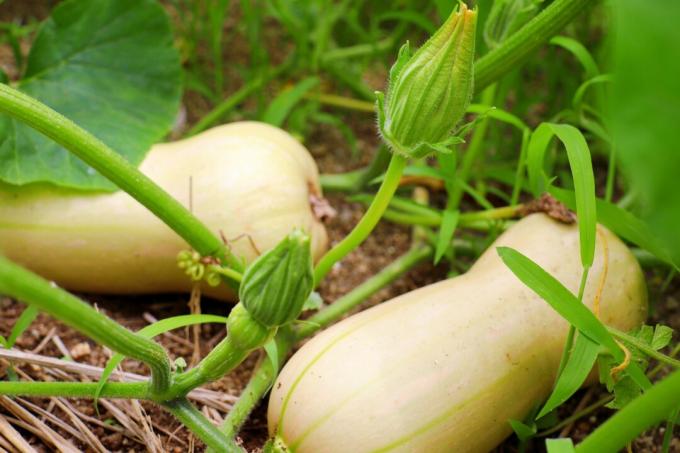You can recognize the butternut squash immediately by its pear-like shape and beige skin. With us you can find out everything you need to know to successfully grow butternut squash.

The butternut squash can be prepared in a variety of ways and impresses both in terms of taste and ingredients. Since the winter squash has a long shelf life, it can be enjoyed over a long period of time. We provide tips on growing, caring for and harvesting butternut squash in the garden.
contents
- Butternut squash: appearance, properties and origin
- The best varieties for the garden
- Plant butternut squash
- Caring for the butternut squash: cutting, fertilizing and Co.
- Harvest butternut squash
- Store butternut squash and preserve it
-
Preparing the butternut squash
- Can you eat butternut squash with the skin on?
- Can butternut squash be eaten raw?
Butternut squash: appearance, properties and origin
The popular butternut squash form a subgroup of the musk squash (
Cucurbita moschata) and are available in different variations. How to get it from the zucchini (Cucurbita pepo subsp. pepo convar. giromontiina) or other cucurbitaceae plants, the butternut squash also has large, heart-shaped leaves that are downy to rough-haired. The leaves are green, have silvery veins or are often sprinkled with silvery-white spots. The funnel-shaped, orange-colored flowers are not only eye-catching, but also edible. It is an annual herbaceous plant that originally comes from South America, but is now grown as a popular vegetable in large parts of the world. The shoots grow climbing over the ground or can climb up on supports. The fruits, i.e. the butternut squash itself, are light yellow to beige in color and elongated, pear- or peanut-shaped. They have a rather thin shell. This contains the melon-scented, deep orange pulp and only a few seeds. This pumpkin is in contrast to the Spaghetti squash (Cucurbita pepo) not fibrous, even after cooking, but rather soft, and tastes mildly sweet. The butternut squash, butternut squash or simply butter squash probably got its name from its buttery, nutty pulp.
The best varieties for the garden
The butternut squash already forms its own subgroup among the musk squash, but there are numerous varieties of it.
- ‘Butterfly F1‘: Italian variety with 3 - 4 kg heavy, slightly ribbed fruits. The hybrid variety grows quite compact and ripens from the end of September.
- ‘Early Nutter F1‘: High-yield hybrid variety with slim fruits that weigh around 1.4 kg. The fruits are ripe for harvest about 90 days after pollination.
- ‘Honeynut‘: Ideal pumpkin for one or two people, because the fruits only weigh just under 0.5 kg. The skin is light yellow to light beige in color. Inside there are very few seeds and a lot of pulp.
- ‘Ponca‘: American, high-yielding butternut variety weighing 0.5 to 1 kg. The numerous, small fruits ripen reliably even in cooler summers.
- ‘Tahiti Melon‘: Butternut variety with a round body and incomparably long necks, almost like a swan. This variety has a particularly sweet, almost melon-like taste.
- ‘Waltham‘: Pear-shaped butternut with a light beige color and fruits weighing up to 2 kg. The ripening takes place late from the end of September to October.

Plant butternut squash
If you want to plant a butternut squash yourself, you should put the seeds on the windowsill in spring. That can happen from April, because it is already warm enough in the apartment for that. To make it easier for the butternut seeds to germinate, it is best to use potting soil, such as ours, to start with Plantura organic herb & seed compost. This is less nutrient-rich than classic potting soil, so that the seedlings develop a larger root system in order to get enough nutrients. The seeds should be covered with soil and set about 3 cm deep in the soil. Keep the seeds evenly moist and warm at around 20 to 24 ° C. After germination, which takes about 7 to 14 days, the plants are placed in a sunny spot by the window.
In addition to bought seeds, you can also dry seeds from self-harvested fruits and sow them in the next spring. However, since pumpkins are strict cross-pollinators, they cross easily with other pumpkins. It can then happen that also contain bitter substances and thus poisonous pumpkins develop. Even with seeds and fruits bought from the supermarket, the formation of bitter substances cannot be completely ruled out. Therefore, you should always orientate yourself on the taste and under no circumstances eat bitter pumpkins.

As soon as they have formed the first real, heart-shaped leaf, prick the pumpkin plants into nutrient-rich potting soil and larger pots. After the gradual hardening of the plants from the beginning of May, nothing stands in the way of moving to the open field after the ice saints in mid-May. When planting out, there should be a distance of at least one meter between the plants. For spreading varieties, around two square meters per plant are estimated.
An ideal place for butternut squash cultivation is right next to the compost or on very nutrient-rich and permeable soil in the sun. To improve it, you can either mix in compost or enrich it with a nutrient-rich substrate like ours Plantura organic compost at. Our organic soil is ideal for all kinds of vegetables that have a high nutritional requirement. The large proportion of organic matter also has a positive effect on soil life in the garden.
Tip: A well-tried cultivation culture is the so-called Milpa bed, in the corn (Zea mays), Beans (Phaseolus vulgaris) and pumpkin are grown together and where each vegetable benefits from each other's properties.

Caring for the butternut squash: cutting, fertilizing and Co.
Pumpkin plants need a lot of water to grow. You should therefore water the butternut squash frequently, especially after it has been planted out and during the dry periods of summer. Always water in the soil and not on the large leaves to prevent diseases such as powdery mildew. Waterlogging must not arise. Lukewarm rainwater or stale tap water are ideal for watering.
The nutritional requirements of pumpkins are also quite high. They belong like tomatoes (Solanum lycopersicum) to the heavy consumers. As soon as the first blossoms appear, you should therefore fertilize the butternut squash. For plants that are intended for consumption, an organic fertilizer, such as ours, is recommended Plantura organic tomato fertilizer. It is a slow release fertilizer in which the nutrients are slowly released over a period of three months.

For an appealing butternut squash harvest, it is worth cutting off the shoots from around five fruit sets per plant so that more and more are not formed. Alternatively, pick the five most promising pumpkins early on, as soon as they can be seen after flowering. The remaining fruit sets are removed along with their side shoots.
Harvest butternut squash
You can harvest the butternut squash in autumn between September and October. It is important that the harvest takes place before the temperatures outside are frosty. Because the heat-loving vegetables cannot tolerate frost. You can tell that the butternut squash is ripe by the following characteristics:
- The hard shell sounds hollow when you knock
- Strongly lignified, brown fruit stalk that is difficult to cut
- Variety-dependent color achieved, usually light yellow and streak-free
A soft stem is a sign that the butternut squash is still immature. For lager pumpkins, it is essential that you leave the stem on the fruit during harvest so that no rot can penetrate at this point later.

Can butternut squashes ripen? Like all pumpkins, butternut pumpkins can also ripen. This is especially useful if you had to be harvested early because of the approaching frost. To do this, store the pumpkin dry and warm, at 15 to 20 ° C, preferably on a dry surface such as straw. Turn the pumpkin regularly to prevent rot and bruises and to provide ventilation.
Store butternut squash and preserve it
In order to store the butternut squash, you need similar conditions as for the post-ripening. It can be a little cooler, but not colder than 10 ° C. Around 15 ° C is ideal. An air-dry environment is also important so that the pumpkins do not rot. You can hang the fruits individually in nets, store them in boxes or on straw. The pumpkins should not touch each other during storage. So the butternut squash can be enjoyed until next spring.
Alternatively, it can be made durable by chopping it up and freezing it. The butternut squash can even be kept for up to a year when boiled in salt water.
You can also prepare the butternut squash first, for example as a soup, then freeze the whole dish to make it durable.

Preparing the butternut squash
Since the butternut squash is healthy and contains many valuable ingredients, it is a very popular vegetable. The content of beta-carotene, vitamins A and C have a positive effect on eyesight, as well as on skin and hair. In addition, the pumpkin has a low fat content. The butternut pumpkin seeds, which are often only a few, are also edible and very healthy. You can season them and roast them in the oven to make a delicious snack.
There are tons of ways to prepare the butternut squash. For example, as a delicious pumpkin soup, but also as a noodle sauce or as oven vegetables, the pumpkin convinces with its buttery-nutty taste.

Can you eat butternut squash with the skin on?
The butternut squash skin is edible, but it is usually removed. It is quite hard and does not soften properly even when cooked, so that many find the consistency unpleasant when eating.
Can butternut squash be eaten raw?
Pumpkins like the butternut squash can be eaten raw. However, the shell should be removed here beforehand.
In addition to edible pumpkins such as butternut, there are also decorative pumpkins that are not suitable for consumption. We have one for you Overview of edible and poisonous pumpkin varieties compiled.



